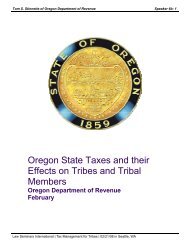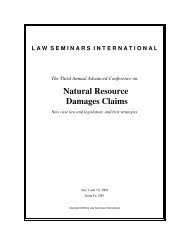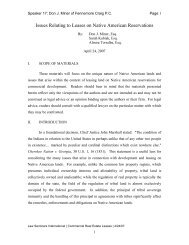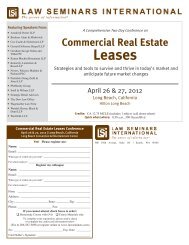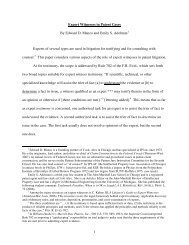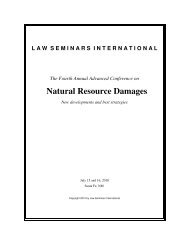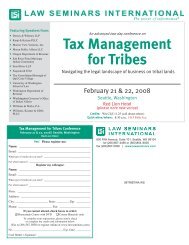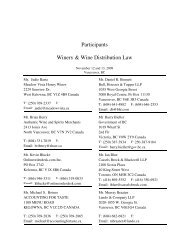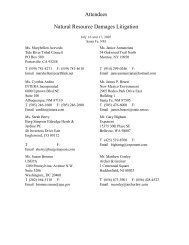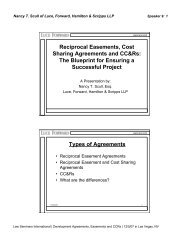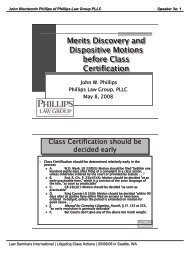LSI 2010 Real Estate Joint Ventures conference materials.pdf
LSI 2010 Real Estate Joint Ventures conference materials.pdf
LSI 2010 Real Estate Joint Ventures conference materials.pdf
You also want an ePaper? Increase the reach of your titles
YUMPU automatically turns print PDFs into web optimized ePapers that Google loves.
John W. Hanley, Jr. of Davis Wright Tremaine LLP Speaker 20a: 11<br />
should be borne by the fund, not by the manager. In the fund sponsor’s view, the appropriate<br />
mechanism to effect this allocation of responsibility is indemnification of the manager (and,<br />
typically, his affiliates, directors, officers, personnel, employees and agents) by the fund itself.<br />
The scope of this indemnification frequently shields against claims and liabilities arising out of,<br />
or related to, almost any conduct under the fund charter or in pursuit of fund objectives.<br />
Frequently the only stated exceptions to this general indemnity umbrella relate to circumstances<br />
where there has been a demonstrated (and usually egregious) failure by the management team to<br />
conform to the stated or expected standard of conduct – most notably, self-dealing by the fund<br />
manager. There has also typically been an exception from indemnification for “gross<br />
negligence” by the manager. Some investors have pushed to expand that exception to include<br />
conduct which amounts to “mere” negligence by the manager, but fund sponsors have resisted<br />
and, at least before the market crashed, this was not a market standard term.<br />
A related issue concerns the strength of the indemnity commitment made by the fund to<br />
the manager. During its life, the fund will (presumably) have the financial strength (i.e., its<br />
portfolio of assets) to make the indemnity meaningful. However, the fund sponsor may also be<br />
concerned about the possibility of a claim against him after the fund has been liquidated. It is<br />
relatively unusual, but a fund charter may contain a clawback provision pursuant to which, for a<br />
limited period of months or years following fund termination, the investors will be obligated to<br />
return to the fund such monies, from their respective distributions, as are needed to meet the<br />
fund’s continuing tail obligation to indemnify the manager for fund-related claims and liabilities.<br />
Removal of Manager. Investors usually expect to have the right to remove the fund<br />
manager from his position of control in a variety of circumstances that threaten the fund’s<br />
survival or profitability. Frequently, this removal power will be exercisable only upon the<br />
occurrence of a “for cause” circumstance, which may be described in the limited liability<br />
company agreement as conviction of a crime, willful malfeasance or other forms of egregious<br />
conduct. The investors may press for the right to remove the manager without having to prove<br />
“cause,” but fund sponsors typically resist. Such a right is usually provided, at all, only if upon<br />
the occurrence of a specific sign of significant financial distress and only if exercised by a super<br />
majority of members.<br />
The fund charter should specify the mechanics for exercise of the members’ removal<br />
power, if any; in particular, whether a formal vote of (or consent by) the non-managing members<br />
will be required (if so, and at what level). The fund’s operating agreement should also address<br />
the consequences of removal, which may vary depending upon the grounds for removal. In the<br />
instance of removal for cause, the fund manager might forfeit his promoted interest and also<br />
suffer some form of dilution or loss with respect his own invested capital in the enterprise. In<br />
other forms of removal, there might be a less draconian consequence, such as a forfeiture of<br />
projected economic return but payment of some compensatory or reimbursement amount to<br />
mitigate the loss. Finally, the investors should consider the impact of removal of the fund<br />
manager on (i) any rights the manager or an affiliate may hold as a member by virtue of having<br />
made its own capital investment in the fund, (ii) ongoing contract relationships with the fund<br />
held by affiliates of the manager, such as a property management contract, and (iii) the impact of<br />
the change in fund management on the fund’s important third party contracts – especially the<br />
mortgage financing for its portfolio assets.<br />
DWT 13620946v1 0000099-071219<br />
Law Seminars International | <strong>Real</strong> <strong>Estate</strong> <strong>Joint</strong> <strong>Ventures</strong> and Funds | 02/09/10 in Seattle, WA<br />
10




